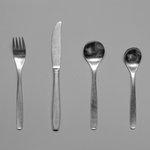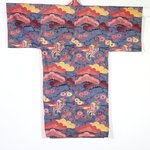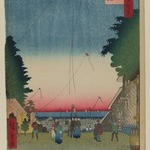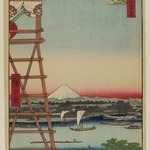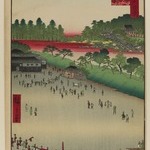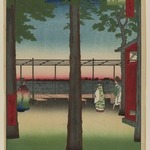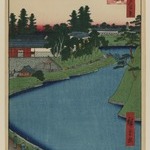
Nihonbashi, Clearing After Snow, No. 1 in One Hundred Famous Views of Edo
Utagawa Hiroshige
Asian Art
How can a single composition document the city of Edo during the mid-nineteenth century? Three iconic images of Japanese culture during the time of Hiroshige are joined in this print, which was chosen to introduce the series: in the background, the perfect form of Mount Fuji, symbol of nature and the divine; at the right, Edo Castle, representing political power; and in the foreground, riverside scenes teeming with activity, emblematic of the common people. The snowy scene is cast in morning light, at the great Bridge of Japan, or Nihonbashi, from which distances to all parts of Japan were measured.
MEDIUM
Woodblock print
DATES
5th month of 1856
PERIOD
Edo Period, Ansei Era
DIMENSIONS
Image: 13 3/8 x 8 3/4 in. (34 x 22.2 cm)
Sheet: 14 3/16 x 9 1/4 in. (36 x 23.5 cm) (show scale)



SIGNATURE
Artist Hiroshige-ga, Publisher Shitaya Uo Ei
COLLECTIONS
Asian Art
ACCESSION NUMBER
30.1478.1
CREDIT LINE
Gift of Anna Ferris
PROVENANCE
Prior to 1930, provenance not yet documented; by 1930, acquired by Anna Ferris of Summit, NJ; 1930, gift of Anna Ferris to the Brooklyn Museum.
Provenance FAQ
CATALOGUE DESCRIPTION
This iconic view of Edo is the symbolic opening of the series. From an elevated viewpoint, it looks west across Nihonbashi, the Bridge of Japan, Bridge of the Rising Sun, across the grounds of Edo Castle to the upper right, toward the perfect form of Mount Fuji to the left.
"Everything in this view suggests freshness and plenty. It is an early morning after new snow, and the morning sun casts reddish bands from behind us to middle left and upper right. Reading from the bottom, we first encounter the Edo fish market and can see fresh fish of all sizes already laid out for display, the street filling with browsing retail vendors and street peddlers. Up the river come the fishing boats, riding in on a deep fan of blue that suggests the sea and its bounty. These are the oshi-okuribune, which relied on oar power as well as the wind to get their produce to the morning market on time. They are covered with mat-roofs to protect the freshness of their cargo. The great bridge itself, from which distances to all parts of Japan were measured, is already busy with early morning traffic, its size approximately exaggerated. Beyond it to the right is ikkokubashi (see pl. 45). Just above it to the left stand fireproof mud-walled storehouses. Far out of scale and imprecise in placement, these white faces and tiles roofs are again symbolic, representing the power of the city of Edo to provide for its citizens, a promise that was rarely broken." (H. Smith, in Braziller, N.Y. 1986)
EXHIBITIONS
MUSEUM LOCATION
This item is not on view
CAPTION
Utagawa Hiroshige (Japanese, 1797–1858). Nihonbashi, Clearing After Snow, No. 1 in One Hundred Famous Views of Edo, 5th month of 1856. Woodblock print, Image: 13 3/8 x 8 3/4 in. (34 x 22.2 cm). Brooklyn Museum, Gift of Anna Ferris, 30.1478.1 (Photo: Brooklyn Museum, 30.1478.1_PS20.jpg)
IMAGE
overall, 30.1478.1_PS20.jpg. Brooklyn Museum photograph, 2023
"CUR" at the beginning of an image file name means that the image was created by a curatorial staff member. These study images may be digital point-and-shoot photographs, when we don\'t yet have high-quality studio photography, or they may be scans of older negatives, slides, or photographic prints, providing historical documentation of the object.
RIGHTS STATEMENT
No known copyright restrictions
This work may be in the public domain in the United States. Works created by United States and non-United States nationals published prior to 1923 are in the public domain, subject to the terms of any applicable treaty or agreement.
You may download and use Brooklyn Museum images of this work. Please include caption information from this page and credit the Brooklyn Museum. If you need a high resolution file, please fill out our online application form (charges apply).
The Museum does not warrant that the use of this work will not infringe on the rights of third parties, such as artists or artists' heirs holding the rights to the work. It is your responsibility to determine and satisfy copyright or other use restrictions before copying, transmitting, or making other use of protected items beyond that allowed by "fair use," as such term is understood under the United States Copyright Act.
The Brooklyn Museum makes no representations or warranties with respect to the application or terms of any international agreement governing copyright protection in the United States for works created by foreign nationals.
For further information about copyright, we recommend resources at the United States Library of Congress, Cornell University, Copyright and Cultural Institutions: Guidelines for U.S. Libraries, Archives, and Museums, and Copyright Watch.
For more information about the Museum's rights project, including how rights types are assigned, please see our blog posts on copyright.
If you have any information regarding this work and rights to it, please contact copyright@brooklynmuseum.org.
RECORD COMPLETENESS
Not every record you will find here is complete. More information is available for some works than for others, and some entries have been updated more recently. Records are frequently reviewed and revised, and we welcome any additional information you might have.




